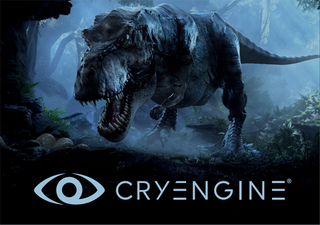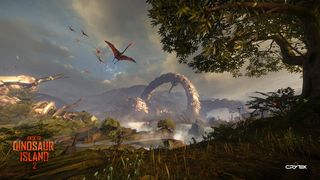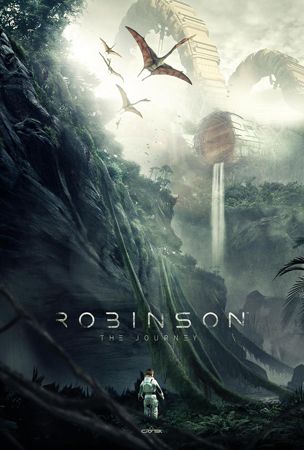On VR With Crytek CryEngine Creative Director Frank Vitz

The Immersed Europe VR and AR Conference was held earlier this month in Spain. As a media sponsor, we were there to cover the event, and we got a chance to speak to many of the speakers who appeared. One of the headlining speakers was Crytek's Frank Vitz. Frank is currently the Creative Director of CryEngine, the advanced graphics engine used by titles such as Crysis, the upcoming Star Citizen, and many VR projects in development.
Crytek is not only heavily involved in the VR development space with CryEngine; it's also working on its own VR game, Robinson: The Journey, which we wrote about earlier this summer.
Prior to working at Crytek, Frank was the Creative Director of the Frostbite engine development team at EA, and before working in games, he worked in the visual effects industry for many years. As the Visual Effects Supervisor for movies like the first two new X-men films, he led the team that created all of Mystique's transformation effects. (He also worked on Tron.)
We asked Frank to talk about his role at Crytek, what plans the company has for the VR space, and his thoughts on the current state and future of VR technology.
TH: Can you tell our readers a little about your background and what you do in relation to VR at Crytek?
FV: My pleasure! I enjoy talking about VR and where I think it is headed. I have been working in computer graphics, animation, and video games for a long time. I worked on movies like Tron, X-Men, and Stargate as well as some very high-tech theme park attractions, interactive museum displays, video games, and even some weird art installations that defy classification! I have also worked with several prototype versions of virtual reality over the years. For me, it is great to see the promise of VR finally making it into the mainstream.
I have held a number of different positions in my career, including Technical Director, Art Director, and Visual Effects Supervisor. Currently, I am the Creative Director for the CryEngine team at Crytek. As you know, CryEngine is a very advanced game engine that is designed for today's groundbreaking interactive VR experiences. We're determined to make it the best VR engine there is.
Stay on the Cutting Edge
Join the experts who read Tom's Hardware for the inside track on enthusiast PC tech news — and have for over 25 years. We'll send breaking news and in-depth reviews of CPUs, GPUs, AI, maker hardware and more straight to your inbox.
TH: We do think that it is very interesting that someone who worked on Tron is now working on technology that will make immersive virtual worlds possible. Did you ever imagine that you'd see VR tech like you are working with today in your lifetime?
FV: Well, actually yes. When I worked on the original Tron movie with its immersive digital game world, I knew even then that what we were creating was a glimpse of the actual future. What has surprised me, frankly, is how long it has taken us to get to this point. It does make for a nice circular symmetry in my career, though!
TH: Why does Crytek think VR is important to invest in, and why is it one of the few large game development studios putting a lot of resources into developing VR?
FV: At Crytek we believe that VR is a whole new entertainment medium full of potential to open up new worlds of previously unimaginable interactive experiences. While VR leverages many of the same technologies and tools that are used in games and movies, it requires VR specific tools and workflows to make it succeed.
Crytek has always been a leader in new graphics technologies, and we believe that we can provide content creators with exactly the tools they need for VR. We are inventors and storytellers at heart after all, and this is our passion. Judging from the enthusiasm and public interest today in VR, we also believe that it makes business sense, especially if we can make CryEngine the go-to tool set for VR.

TH: We were able to try Back to Dinosaur Island 2 at E3, and you have also announced Robinson: The Journey. Can you update us as to where you are with Robinson since we last wrote about it?
FV: We are continuing to work on the project. We have a team developing the design of the world and characters, the context and storyline, even as we expand our VR toolset in CryEngine and invent new game mechanics that will make the game fun in VR. For me, Robinson is such a great concept; it is BIG and full of potential adventures.
TH: Would it be fair to say that Crytek has always been the game studio that likes to push the technical boundaries? "Will it run Crysis?" was the question put to every gaming PC. Will that question change to "Will it run Robinson: The Journey?"
FV: Yes, we do like to push the envelope. CryEngine has always taken the lead with regard to new graphics features. However, it has also led the way in terms of rendering speed and resolution…it is optimized to deliver the highest possible quality from whatever computer it happens to be running on. This capability is even more important in VR, where high resolution, frame rates and visual fidelity are critical.
TH: With many of the VR display hurdles overcome with the newest HMD and graphics cards technology, the next challenge is input. Both Oculus and Valve have promising motion control technology, and there are of course other players like Leap Motion and Intel with its RealSense technology. What are your thoughts on input for VR?
FV: I think that motion control is going to be very important for a real sense of immersion. It is amazing what a difference it makes when you can reach into the world that you are seeing and feel like you are grabbing hold of things. We are already testing a range of devices in order to develop a standardized way of interfacing with them in the engine. We are also developing our VR input scheme to support the base case of a standard gamepad controller, as well as a variety of motion controllers. That way we can ensure a good experience for the user no matter what configuration they have.
TH: Another challenge, especially when talking about Steam VR and the HTC Vive, is locomotion in room-scale VR. Cloudhead Games recently announced its Blink technology, which looks to be a good solution. How would you address locomotion when working within the physical limits of this type of VR?
FV: For Robinson, we have been experimenting with UI designs and elements that address locomotion issues. We have experimented with several different techniques to communicate boundaries of the playspace, preserve the player's sense of orientation when they move, and so on. These techniques are promising, but nausea-free movement and navigation in an extended space in VR is still a work in progress.
TH: Moving a little bit away from VR for gaming, as someone who has a background in the film industry too, can you talk a little about how you've been able to apply some of the skills from that side to VR?
FV: Well, I have been a contributor to and commentator on the convergence of film and games for a long time. We see game engineers adopting the digital techniques from movies and optimizing them to run in real time. We see the principles of movie cinematography being applied to game design. And so on. This convergence continues; in fact, it is even stronger in the VR domain. For example, I worked on film projects that involved creating emotionally believable digital characters. We developed scanning and performance capture technology along with shaders able to reproduce realistic humans on screen. Later we moved that technology into game engines, and now we are doing it in VR.

TH: We recently saw Oculus Story Studio's Henry and were impressed. What are your thoughts on using VR for entertainment other than gaming, such as cinematic storytelling?
FV: I believe that in some ways, VR is positioned right at the convergence of movies and games. There is actually a spectrum of interactive experiences possible between the two…from the classic single-perspective linear movie to a linear 360 [degree] FOV movie, stereoscopic linear 360 [degree] movie, branching linear 360 [degree] experience, open world interactive VR, to classic single-perspective interactive video game. And of course, there are lots of permutations along this spectrum. I do think that there are fantastic possibilities for cinematic storytelling in VR, where traditional directors can leverage their experience in choreography and sequencing to tell a story, even as we figure out a whole new language for scene composition, transitions and directing the audience's attention in the VR space.
TH: There are still many naysayers who doubt VR will be successful. How would you address some of their concerns?
FV: There were naysayers about smartphones when they first started to hit the market, but today they are woven into the fabric of our everyday lives. I think that VR is going to follow a similar trend. There will be challenges, of course, but broadly speaking, technology is no longer a barrier. Now it's about using that technology to deliver meaningful experiences that enhances people's lives – whether through entertainment or other applications. The potential is limitless. Moreover, it's those experiences that will drive mass market penetration.
*****
Clearly, both Crytek and Frank are firm believers in the future of VR and are investing heavily in creating tools to help create some amazing immersive experiences. We are looking forward to playing both Robinson: The Journey and the many VR games that will come out powered by CryEngine.
Though Immersed Europe is now over, the next few weeks are going to be very important for VR enthusiasts. Yesterday marked the start of Oculus Connect, Oculus's annual VR developer conference, and we are there covering it and will be sure to bring you all the news.
Also, the next Immersed Conference takes place in Toronto, Canada, from October 4–6, and once again we are media sponsors, so stay tuned for extensive coverage. Immersed has some great speakers lined up, including Dr. Richard Marks, Director of PlayStation's Magic Lab, where PlayStation VR was developed, and the founder of the HTC Vive, Phil Chen.
Alex Davies is an Associate Contributing Writer for Tom's Hardware and Tom's IT Pro, covering Smartphones, Tablets, and Virtual Reality. You can follow him on Twitter. Follow Tom's Hardware on Twitter, Facebook, and Google+.
-
uglyduckling81 Sounds like a guy that's not all that happy at Crytech.Reply
"I'm currently lead VR at Crytech", or what ever his position he said was. Then goes on to talk about his extensive experience. Tom's is helping this guy find a new job. This article is actually a resume.
Anyone need a VR guy? -
scolaner ReplySounds like a guy that's not all that happy at Crytech.
"I'm currently lead VR at Crytech", or what ever his position he said was. Then goes on to talk about his extensive experience. Tom's is helping this guy find a new job. This article is actually a resume.
Anyone need a VR guy?
If that's all you got out of the article, that makes me sad.
Most Popular

